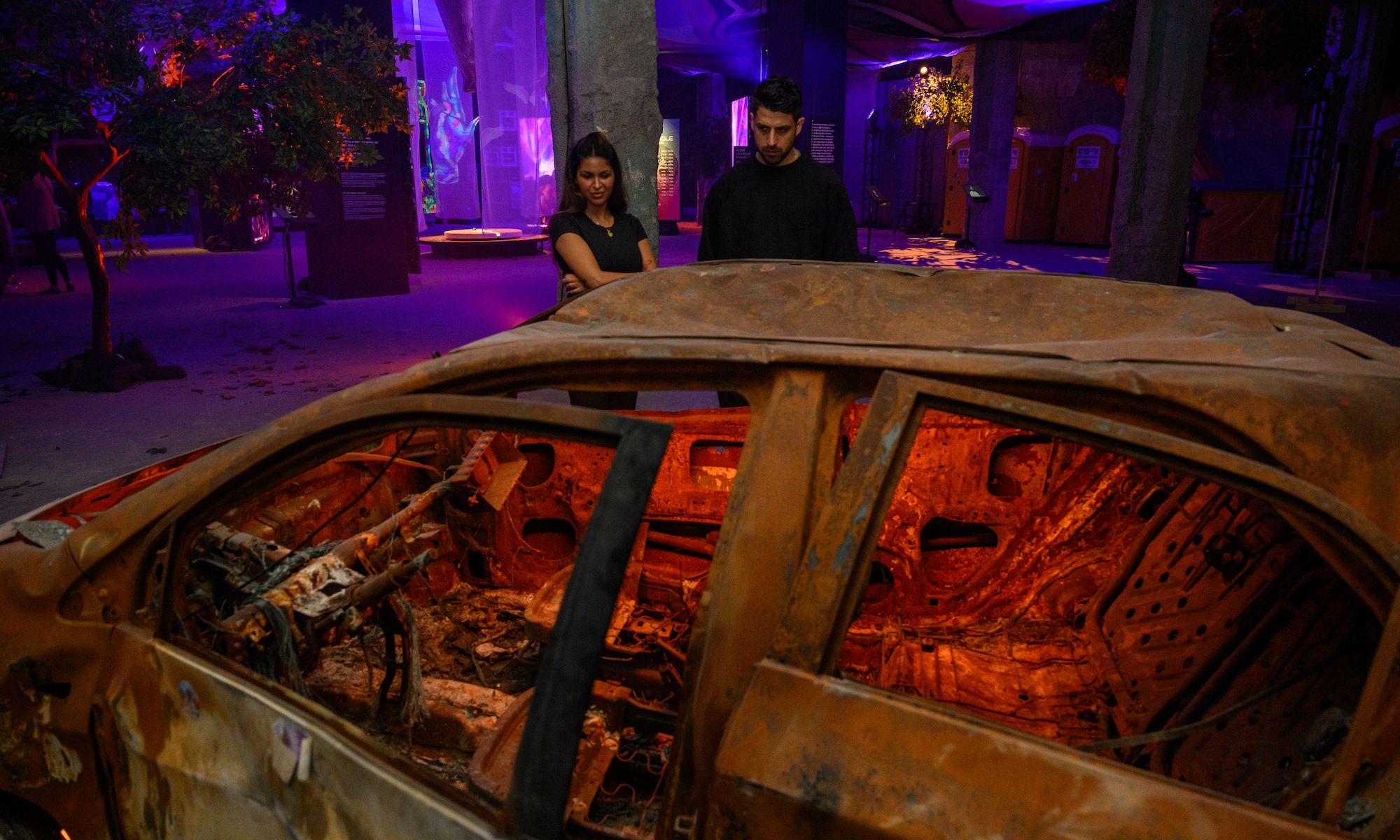Nova survivor Natalie Sanandaji, and Reef Peretz, chairman of the Nova Foundation, look at destroyed cars taken from the Nova festival at the Nova Music Festival exhibition, October 7th 06:29 AM, The Moment Music Stood Still, in New York City Photo by Alexi Rosenfeld/Getty Images for The Nova Music Festival Exhibition
The exhibition 06:29 am: The Moment Music Stood Still opened to the public in New York City on Sunday (21 April) in a 50,000 sq. ft space at 35 Wall Street (until 23 May). The installation painstakingly recreates the grounds of the Supernova Sukkot Gathering, the open-air Tribe of Nova trance music festival in Re’im, Israel. More than 3,000 concertgoers gathered on the evening of 6 October 2023 for an event meant to last through the following day. At sunrise on 7 October, Hamas terrorists attacked the festival, killing more than 360 people and taking 44 hostages. (Hamas attacks on Israel that day killed around 1,200 people in total, with around 250 people taken hostage.)
Objects from the site of the massacre—including charred cars, bullet-pocked portable toilets, empty liquor bottles, camping tents, plastic cups, overturned chairs, sneakers, jewellery, backpacks and T-shirts—create an immersive, harrowing journey, from a night of revelry to a morning of horror.
The Manhattan exhibition follows an eight-week run in Tel Aviv, after which each artefact was collected, crated and shipped to New York by boat, with the approval of Israeli authorities. Most of the objects on display remain state assets, says Yoni Feingold, one of the exhibit’s co-founders. His wife, Reut Feingold, is the project’s creative director. Under her direction, numerous pictures and videos informed a tireless process of re-creating of the attack’s aftermath.
Screens showing clips from the attack on Nova are displayed next to personal and camping items taken from the festival, re-creating the festival layout at the Nova Music Festival exhibition, October 7th 06:29 AM, The Moment Music Stood Still in New York City Photo by Alexi Rosenfeld/Getty Images for The Nova Music Festival Exhibition
Upon entry, visitors encounter a film of celebratory festivalgoers, dancing before the carnage. The exhibit then leads visitors into what the organisers call the “attack room”—with sleeping bags, cell phones and other objects left behind by fleeing victims—and into the “Nova room”, an exacting re-creation of the festival’s main stage and bar. A soundtrack of pulsing trance beats augments the disorienting chaos of the experience.
“The intention is to make it really feel that you’re out in a eucalyptus field,” says Virginia Fout, the exhibition’s production manager. In Tel Aviv, the installation used actual trees, but due to seasonal limitations, 26 matching, artificial ones were fabricated for the New York edition. “The hope is that the exhibition travels, with a life in multiple venues where these trees can be used,” she explains. “As you manoeuvre through the campsite, you navigate the varying heights of trees. We want to bring the reality of camping in the bush to the exhibit. There’s also dirt on the floor.”
Reef Peretz (left), chairman of the Nova Foundation, and Nova survivor Natalie Sanandaji (right) in front of the Nova stage at October 7th 06:29 AM, The Moment Music Stood Still in New York City Photo by Alexi Rosenfeld/Getty Images for The Nova Music Festival Exhibition
The organisers’ approach is reminiscent of the nearby 9/11 Memorial Museum, which includes thousands of objects large and small from the 11 September 2001 terrorist attack on Lower Manhattan that chronicle the experiences of victims, survivors and first responders. “We aimed for the project to be the closest we could bring it to the 9/11 Memorial, because that’s exactly the connection we want people to make,” Yoni Feingold says.
Beyond documenting bloodshed and memorialising the Tribe of Nova festival’s victims, the exhibit’s organisers believe it speaks to the universality of music to bring people together, even at especially divisive moments. “Music is an international language. Whether it’s Coachella or Governors Ball or Glastonbury, we go because that's where we feel connected,” Feingold adds. “There were hundreds of people from abroad that came to this festival. It was a collaboration with DJs from India, Brazil, Europe and the United States.”
The Nova Music Festival exhibition, October 7th 06:29 AM, The Moment Music Stood Still, in New York City Photo by Alexi Rosenfeld/Getty Images for The Nova Music Festival Exhibition
Another of the exhibition’s organisers, Scooter Braun—a record executive who planned the One Love Manchester benefit concert in 2017 following a terror attack at an Ariana Grande concern in that city—believes it isn’t about politics or choosing sides. “When the shooting happened at the Harvest Festival in Las Vegas or the Manchester Arena, the community rallied around each other,” he says. “Nova was the biggest music massacre in history. It’s incredibly important that we, as a community, demand that music stay a safe space.”
Even so, the exhibit’s organisers have implemented strong security measures, with screenings and pre-ticketed entry for visitors. Tickets start at $1, with any additional money donated going to Nova Healing Journey, an initiative supporting victims of the 7 October attack and their families.
The exhibit arrives in New York at a moment of heightened tension around the Israel-Hamas war, in which more than 34,000 Gazans have been killed, according to the most recent figures released by the Hamas-run health ministry in Gaza. Uptown at Columbia University, a standoff between university leaders, the NYPD and pro-Palestine student demonstrators has led to mass arrests, a tent encampment and solidarity protests at universities across the city and country.

